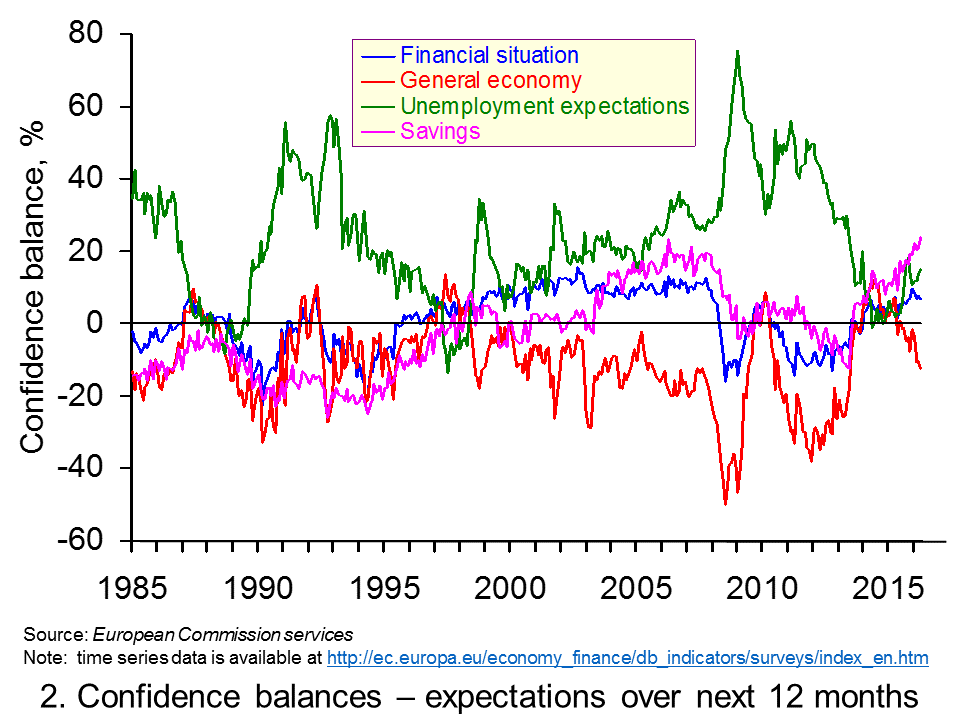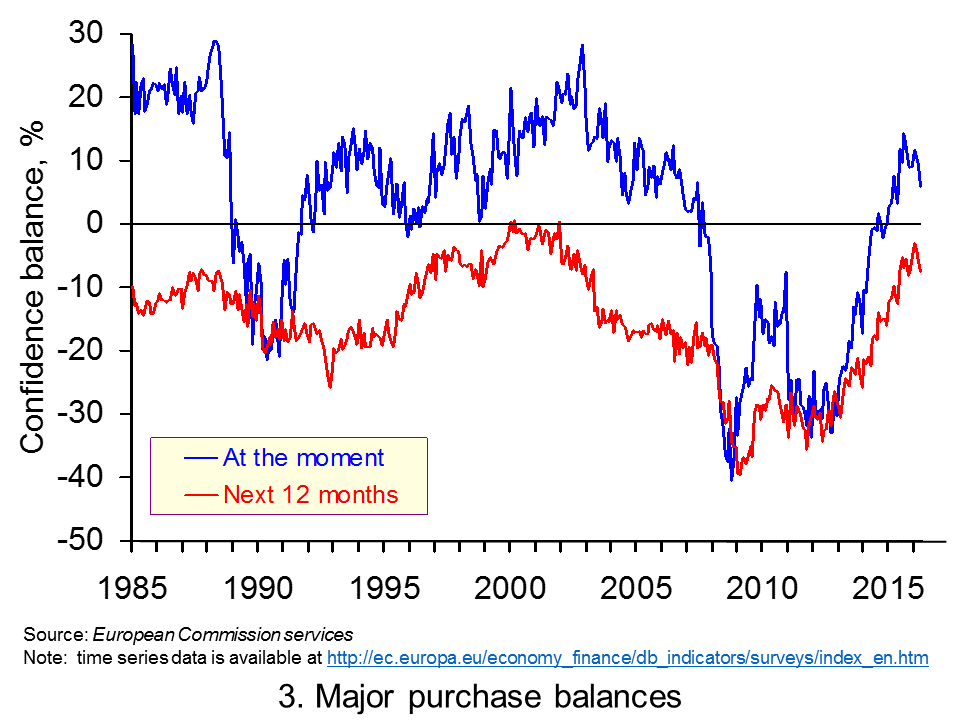What can we read into signs of easing consumer confidence?
 Economists spend a lot of time analysing consumers’ spending intentions. This is unsurprising given that UK household consumption is the equivalent to around two-thirds of Gross Domestic Product. One factor that is argued to affect spending decisions is consumer confidence. Despite a slight easing in recent months, survey data from the European Commission continue to show relatively high confidence levels among UK households. This follows a surge in consumer confidence during 2013 and into 2014.
Economists spend a lot of time analysing consumers’ spending intentions. This is unsurprising given that UK household consumption is the equivalent to around two-thirds of Gross Domestic Product. One factor that is argued to affect spending decisions is consumer confidence. Despite a slight easing in recent months, survey data from the European Commission continue to show relatively high confidence levels among UK households. This follows a surge in consumer confidence during 2013 and into 2014.
 Rising consumer confidence is identified frequently by economists as a positive demand-side shock. Therefore, rising confidence would be expected to boost an economy’s output levels as aggregate demand rises. The opposite holds for falling consumer confidence which is an example of a negative demand-side shock.
Rising consumer confidence is identified frequently by economists as a positive demand-side shock. Therefore, rising confidence would be expected to boost an economy’s output levels as aggregate demand rises. The opposite holds for falling consumer confidence which is an example of a negative demand-side shock.
Given the impact that confidence can have on economies it is important to have measures which might be thought, however imperfectly, to capture consumer confidence. The European Commission’s confidence measure involves a monthly survey of around 2000 individuals in the UK. Across the 28 member states over 41 000 people are surveyed.
In the survey individuals are asked a series of 12 questions which are designed to provide information on spending and saving intentions. These questions include perceptions of financial well-being, the general economic situation, consumer prices, unemployment, saving and the undertaking of major purchases.
 The responses elicit either negative or positive responses. For example, respondents may feel that over the next 12 months the financial situation of their household will improve a little or a lot, stay the same or deteriorate a little or a lot. A weighted balance of positive over negative replies can be calculated. The balance can vary from –100, when all respondents choose the most negative option, to +100, when all respondents choose the most positive option.
The responses elicit either negative or positive responses. For example, respondents may feel that over the next 12 months the financial situation of their household will improve a little or a lot, stay the same or deteriorate a little or a lot. A weighted balance of positive over negative replies can be calculated. The balance can vary from –100, when all respondents choose the most negative option, to +100, when all respondents choose the most positive option.
The European Commission’s consumer confidence indicator is the average of the balances of four of the twelve questions posed: the financial situation of households, the general economic situation,  unemployment expectations (with inverted sign) and savings, all over the next 12 months. The balances are seasonally adjusted.
unemployment expectations (with inverted sign) and savings, all over the next 12 months. The balances are seasonally adjusted.
Chart 1 shows the consumer confidence indicator for the UK. The long-term average of –8.8 shows that negative responses across the four questions typically outweigh positive responses. However, the current confidence balance is just above zero at +0.8. So, as well as indicating a generally positive disposition across UK households, confidence levels are well above the long-term average. (Click here to download a PowerPoint of the chart.)
 Chart 2 enables us to see what has been driving the European Commission’s confidence indicator for the UK by looking at its four component balances. From it we can see that the boost to confidence in 2013 and 2014 coincided with a dramatic improvement in expectations of the general economic situation in the year ahead and a rapidly falling proportion of respondents expecting unemployment to rise.
Chart 2 enables us to see what has been driving the European Commission’s confidence indicator for the UK by looking at its four component balances. From it we can see that the boost to confidence in 2013 and 2014 coincided with a dramatic improvement in expectations of the general economic situation in the year ahead and a rapidly falling proportion of respondents expecting unemployment to rise.
The easing in confidence since the turn of the year appears largely to be the result of deteriorating expectations over the general economy. In April the forward-looking general economic situation balance had fallen to –12.5 the lowest balance since June 2013. The deterioration in this balance slightly lags the growing belief that unemployment will rise over the next 12 months, which began to take hold last Autumn. Some commentators argue these trends might reflect the uncertainty caused by the EU referendum to be held in the UK on 23 June. (Click here download a PowerPoint of the chart.)
The monthly survey contains other questions that can help to predict future spending patterns. For example, we might expect the responses to questions relating to perceptions around what the survey called ‘major purchases’ to give us some important insight in households’ financial well-being and spending plans. ‘Major purchases’ are taken to be items such as furniture, electrical goods and electronic devices.
 Chart 3 shows the balances to both whether now is the right time to make major purchases and to whether respondents expect to spend more on major purchases in the coming 12 months compared to the past 12 months. We can see a marked improvement in sentiment from around the middle of 2013.(Click here to download a PowerPoint of the chart.)
Chart 3 shows the balances to both whether now is the right time to make major purchases and to whether respondents expect to spend more on major purchases in the coming 12 months compared to the past 12 months. We can see a marked improvement in sentiment from around the middle of 2013.(Click here to download a PowerPoint of the chart.)
By the start of 2015 there was a positive balance of individuals feeling that now was the right time to make major purchases. While this balance remained positive in April 2016 at +5.9 this was down from +11.7 back in January. Meanwhile, the forward-looking major purchase balance has fallen slightly in each of the last three months. But, it is still on a par with levels at the end of 2015. Hence, it is perhaps a little too early to talk of any significant easing of forward-looking sentiment around more major purchases having yet become established.
Taking the two major purchase balances together the tentative evidence points to a relatively mild easing in sentiment. This is consistent with the overall consumer confidence indicator.
It would seem that while consumer confidence has eased a touch from the highs of the past couple of years, confidence levels remain strong. Nonetheless, policymakers will be keeping a very keen eye on any signs that this easing in confidence is becoming entrenched with its implications for weaker consumption growth.
Articles
Brexit and euro zone worries weigh on UK consumers Reuters, (31/3/16)
Brexit’s Mixed Messages Depress Consumer Confidence, GfK Says Bloomberg, Fergal O’Brien (29/4/16)
UK consumer confidence stumbles Herald Sun, Dan Cancian (25/4/16)
Consumer ‘depression’ mounts over uncertain economy The Telegraph, Szu Ping Chan (29/4/16)
Consumer confidence at zero as Brexit fears ‘hit home’ The Telegraph, Szu Ping Chan (31/3/16)
Consumer confidence in UK at lowest level in 15 months, survey suggests Guardian, Katie Allen (29/4/16)
Data
Business and Consumer Surveys European Commission
Questions
- Draw up a series of factors that you think might affect consumer confidence.
- Analyse the ways in which consumer confidence might affect economic activity.
- Explain what you understand by a positive and a negative demand-side shock. How might changes in consumer confidence initiate demand shocks?
- Which of the following statements is likely to be more accurate? (a) Consumer confidence drives economic activity. (b) Economic activity drives consumer confidence.
- What macroeconomic indicators would those compiling the consumer confidence indicator hope that the indicator would help to predict?
- In recent times expectations about the path of the economy have been less optimistic. Yet at the same time more people are positive about how their financial situation will develop. What might explain this apparent contradiction?
- What might the long-term average value of the consumer confidence indicator reveal about peoples’ natural perceptions and expectations of their well-being?